We will solve addition and subtraction operations of decimal numbers in vertical form, always keeping in mind the following rules:
• All the rules that are applicable to the addition and subtraction of whole numbers also apply to decimal numbers.
• The decimal points must always be aligned one under the other.
• Numbers must be written in an orderly manner - both to the right of the decimal point and to its left (tenths under tenths, hundredths under hundredths, and so on)
Addition and Subtraction of Decimal Numbers
Simple Operations with Decimal Numbers
Test yourself on addition and subtraction of decimal fractions!
\( \text{0.6+0}.5= \)
How to Add and Subtract Decimal Numbers
In this article, we will learn how to add and subtract decimal numbers in a simple, easy, and quick way.
In fact, adding and subtracting decimal numbers is very similar to operations with whole and common numbers that we already know and can even solve in our heads without needing to write them down.
Let's remember how to add or subtract whole numbers:
When we have an exercise like
Our intuition naturally prompts us to solve it vertically, so we will write:
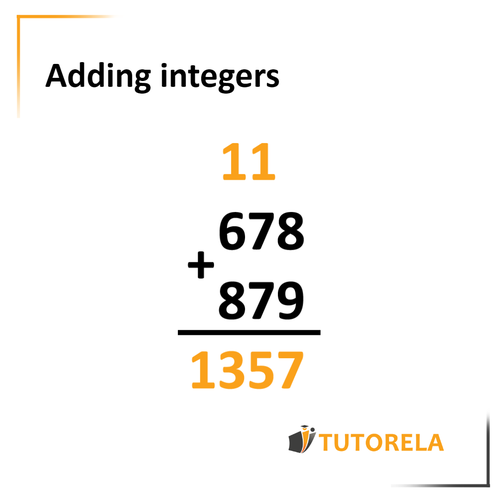
Excellent! After having remembered how to solve addition and subtraction exercises with whole numbers and having paid attention to critical issues such as:
Writing the numbers clearly by placing the corresponding digits on top of each other (hundreds over hundreds, tens over hundreds, and units over units)
and the correct carry over: noting part of the number above in an orderly manner ("remember that I carry one over..."), let's move on to the addition and subtraction of decimal numbers.
We will always solve the addition and subtraction of decimal numbers vertically!
What we need to pay attention to in the addition and subtraction of decimal numbers:
- Write the decimal points one under the other.
- Strictly comply with orderly writing - both in the part of the whole numbers and in the decimals
Hundreds under the hundreds, tens under the hundreds, units under the units,
tenths under the tenths, hundredths under the hundredths, and thousandths under the thousandths. - Be methodical with the correct carry over - in the same way we do in the addition and subtraction of whole numbers, we will proceed according to the general rules of vertical addition and subtraction.
Suggestion: To make the exercise look more organized we can add the figure at the end of the decimal number, to the right, without changing its value.
Now, let's practice
Exercise 1 (addition of decimal numbers)
Solve the exercise:
Solution:
Let's write the exercise in vertical form and pay attention to the rules and the important points we have emphasized before.
Notice, the decimal point is under the other decimal point.
In the result, we will also copy the decimal point to the exact place it originally occupied.
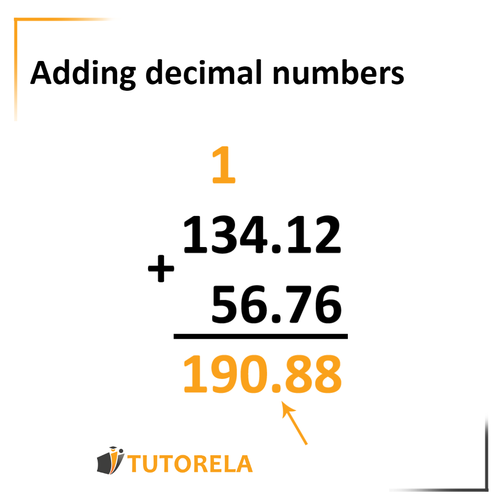
Notice that we have correctly carried over when we added and got .
A notation like this, for example
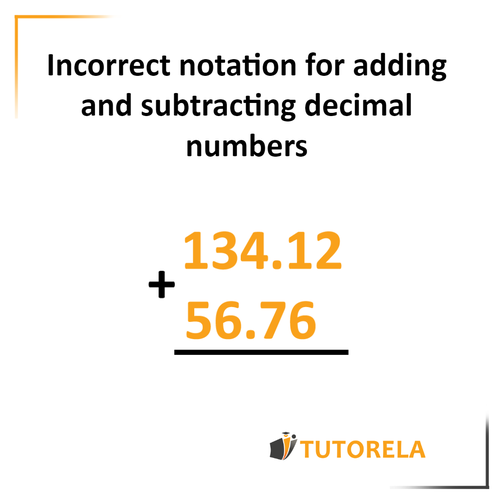
Would be a mistake!
Choose the correct format:
Exercise 2 (addition of decimal numbers)
Let's move on to the next exercise:
Solution:
Let's write it in vertical form, clearly and correctly:
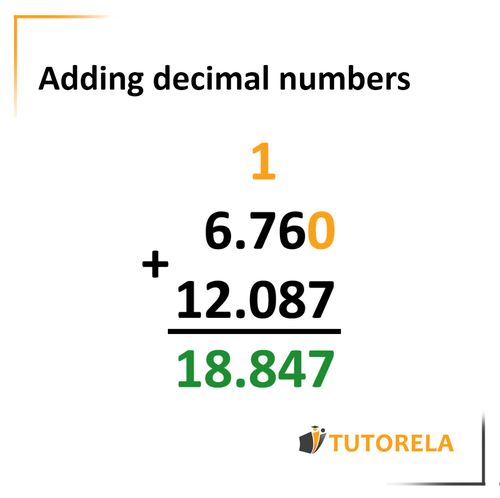
Note: It is extremely important to write in an orderly and clear manner, both the side of the whole numbers and the decimals, to obtain a correct result.
If you do not see the exercise in a very orderly way you can add a 0 that will not affect the numerical value (marked in pink), and thus, get a clearer view of the exercise.
Exercise 3 (addition of decimal numbers)
Now we will see an exercise with carrying over to the part after the decimal point:
Solve the exercise
Solution:
Let's write it correctly:
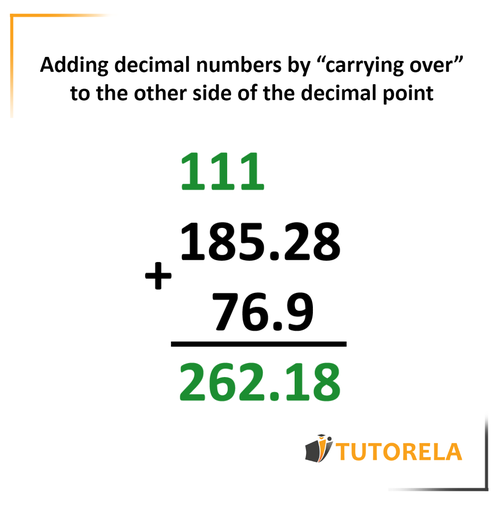
We can see that the number we carried over passed to the other side of the decimal point, this is totally correct.
Now let's move on to a subtraction exercise.
Exercise 1 (Subtraction of Decimal Numbers)
Solution:
Let's write it in an organized way:
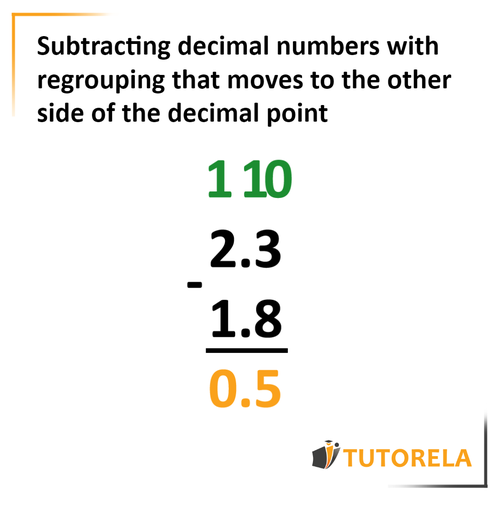
Notice that we need to borrow, we will do it according to the same rules of adding and subtracting whole numbers.
Exercise 2 (Subtraction of Decimal Numbers)
Example of an advanced exercise:
Solution:
In this exercise, we will need to borrow twice.
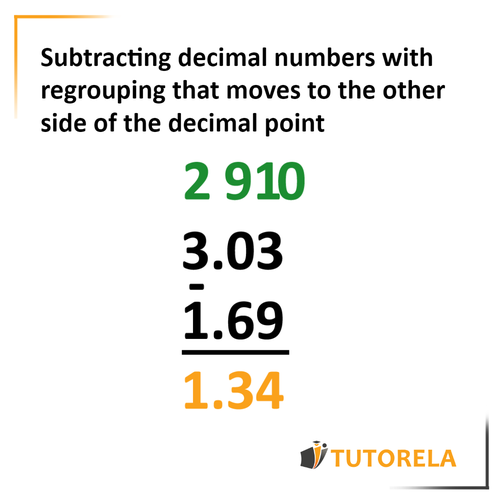
Infallible recommendation:
To always know how to write the exercises correctly, it is advisable that, after noting the first decimal number, you place the decimal point of the second fraction directly below the decimal point of the first fraction, and only after doing this, write the remaining numbers.
When can sums and subtractions of decimal numbers be solved without using the vertical form?
In general, we recommend solving additions and subtractions of decimal numbers only in vertical form.
In case the exercises are very simple (without carrying and without too many digits) they can be solved without arranging them in vertical form. Clearly, everything depends on the instructions noted in the exam.
Example of solution:
Let's add the units and we will get
Let's add the tenths and we will get
Let's add the hundredths and we will get
The solution is
Examples and exercises with solutions for addition and subtraction of decimal numbers
Exercise #1
Step-by-Step Solution
To solve this problem, we'll follow these steps:
- Step 1: Align the numbers and by their decimal points.
- Step 2: Add the numbers as you would do with whole numbers.
- Step 3: Place the decimal point in the sum directly under the decimal points of the addends.
Now, let's work through each step:
Step 1: Write the numbers aligned by the decimal point:
0.6
+ 0.5
Step 2: Add the digits:
- Start from the right: . Place a in the tenths column and carry over .
Step 3: Add the whole number part considering any carry:
- (from the carry) = .
The sum of and gives .
Therefore, the solution to the problem is .
Answer
1.1
Exercise #2
Choose the correct format:
Step-by-Step Solution
To correctly set up a vertical addition of decimal fractions, it is crucial to align the numbers by their decimal points. Let's break down the choices:
Choice 1 presents the numbers in the proper format. The decimal points of and align vertically, ensuring accurate addition.
Choice 2 misaligns the decimal points, incorrectly starting further to the left than necessary.
Choice 3 also misaligns the decimals, wanting to begin even further than choice 2.
Thus, the correct choice is Choice 1, since it correctly aligns the numbers by their decimal points, facilitating accurate addition of the values involved.
Therefore, the correct format choice is Choice 1.
Answer
Exercise #3
Step-by-Step Solution
To solve this problem, start by re-evaluating the appearance of this problem statement:
- This visually seems to indicate finding a valid operation setup with the choice alternatives.
Since the intention is seeming to lead to an operation like:
- Identify that two blocks represent this subtraction problem, further confirming with operation balance .
- Translate this problematically as trying different ensuring subtraction , achieves a valid metric.
- Among choices look into possible well-matching 0.7
Breaking down and confirming,
- : Provides true balance operational correctness reaching through rest items.
Therefore, the correct answer for the problem based on range and method assessment is , also the third choice.
Answer
0.7
Exercise #4
Step-by-Step Solution
To solve this problem, we'll follow these steps:
- Step 1: Identify the value represented by the graphical box. In this context, we assume it likely represents the number .
- Step 2: Subtract from this number, with care for decimal place alignment.
- Step 3: Calculate the result of the subtraction: .
Now, let's work through the detailed steps:
Step 1: Assume and verify within graphical representation contexts that the initial number is likely .
Step 2: Align decimals and perform the subtraction operation:
: Ensure placeholder zero for two decimal spaces.
Step 3: Subtraction takes place across decimals: .
Therefore, the solution to the problem is , which matches choice 1.
Answer
1.7
Exercise #5
Step-by-Step Solution
Let's solve the subtraction problem step by step:
- Step 1: Align the decimal numbers. The subtraction is . Both numbers have their decimal points aligned.
- Step 2: Subtract the numbers starting from the tenths place: (in ) minus (in ). This requires borrowing.
- Step 3: Regroup, take from the units place of , which then becomes (or tenths), thus tenths. Subtract tenths from tenths, resulting in tenths.
- Step 4: The units digit of now, after borrowing, is . There is nothing left to subtract, so the remaining digit in the unit place remains .
- Step 5: Therefore, the answer obtained is .
Thus, the solution to the problem is .
Answer
0.9
Determine whether the exercise is correctly written or not.
True or false:
The positions of the decimal points correspond.
Determine whether the exercise is correctly written or not.
The position of the decimal point corresponds.
Is the following written in the correct format?
More Questions
- Fractions
- A fraction as a divisor
- How do you simplify fractions?
- Simplification and Expansion of Simple Fractions
- Common denominator
- Hundredths and Thousandths
- Part of a quantity
- Placing Fractions on the Number Line
- Numerator
- Denominator
- Decimal Fractions
- What is a Decimal Number?
- Reducing and Expanding Decimal Numbers
- Comparison of Decimal Numbers
- Converting Decimals to Fractions
- Multiplication and Division of Decimal Numbers by 10, 100, etc.
- Multiplication of Decimal Numbers
- Division of Decimal Numbers
- Repeating Decimal
- Decimal Measurements
- Density
- Remainder of a fraction
- Decimal fraction remainder
- Remainders









